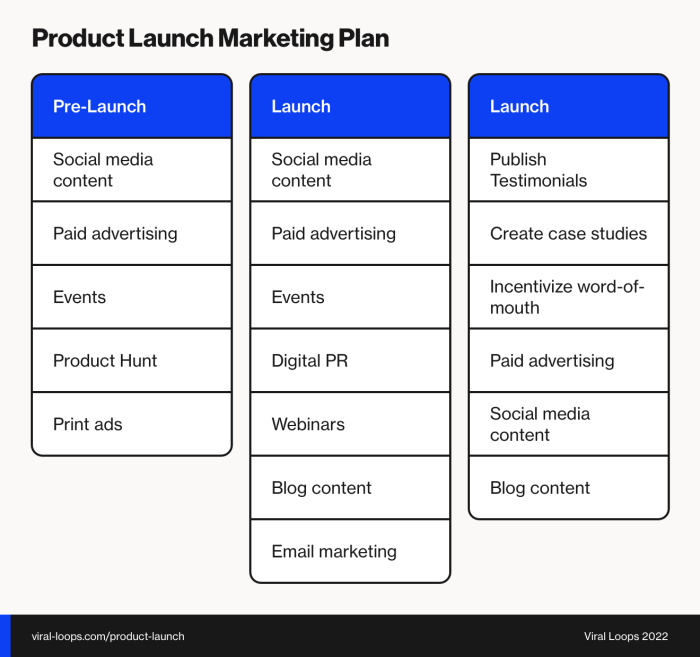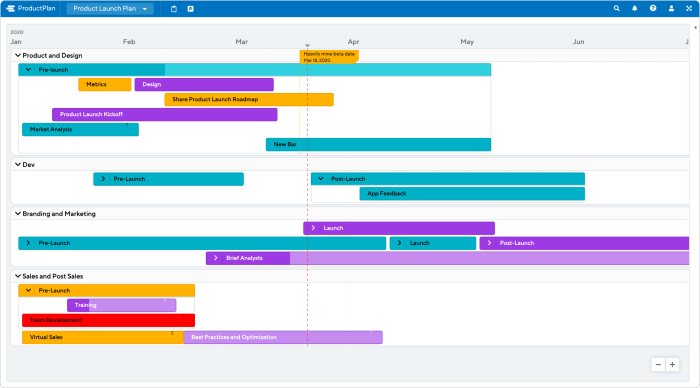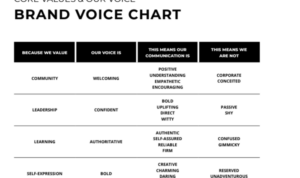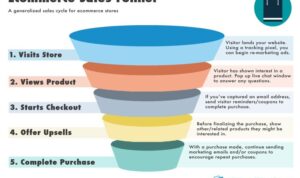Developing a Product Launch Plan sets the stage for a successful unveiling of a new product, guiding you through the intricacies of planning, research, marketing, and evaluation. Dive into this comprehensive guide to unlock the secrets of a stellar product launch.
Introduction to Product Launch Planning
A product launch plan is a detailed strategy outlining the steps and activities required to introduce a new product to the market successfully. It includes aspects such as setting goals, identifying target audience, determining marketing tactics, and establishing a timeline.
Having a well-thought-out product launch plan is crucial as it helps ensure a smooth and organized introduction of the product, maximizing its impact and reach. Without a solid plan, companies risk confusion, poor reception, and missed opportunities for engagement with potential customers.
Importance of a Well-Executed Product Launch Plan
- Creates buzz and anticipation: A well-planned launch generates excitement and interest among consumers, leading to increased awareness and demand for the product.
- Builds credibility and trust: When a product is launched with a clear plan and strategy, it demonstrates the company’s professionalism and commitment to delivering quality offerings.
- Maximizes sales potential: Effective planning allows companies to capitalize on market trends, consumer preferences, and competitive landscape to drive sales and revenue.
Examples of Successful Product Launches
- Apple iPhone: Apple’s product launches are meticulously planned, generating massive hype and demand for their new iPhone models each year.
- Tesla Model 3: Tesla’s launch of the Model 3, with a strategic reservation system and targeted marketing campaigns, resulted in record-breaking sales and market success.
- Disney+: Disney’s streaming service was launched with a well-executed marketing plan, offering exclusive content and leveraging its strong brand to attract subscribers.
Market Research and Analysis
Market research is a crucial step in developing a successful product launch plan. It helps businesses understand the market landscape, identify potential customers, and analyze competitors to make informed decisions.
Significance of Market Research
Market research allows companies to gather valuable insights into consumer behavior, preferences, and trends. By conducting thorough market research, businesses can tailor their product launch strategies to meet the needs and expectations of their target audience.
- Surveys: Gathering feedback directly from consumers through surveys helps in understanding their preferences and expectations.
- Focus groups: Bringing together a diverse group of individuals to discuss and provide feedback on a new product can offer valuable insights.
- Competitor analysis: Studying competitors’ strategies, product offerings, and market positioning can help in identifying opportunities and gaps in the market.
Setting Clear Objectives and Goals
Setting clear objectives and goals is essential for a successful product launch. It provides a roadmap for the team to follow and helps in measuring the progress and success of the launch. Let’s delve into the process of setting SMART objectives for a product launch and understand the difference between goals and objectives.
Setting SMART Objectives
Setting SMART objectives involves creating goals that are Specific, Measurable, Achievable, Relevant, and Time-bound. This ensures that the objectives are clear, focused, and actionable. For example, instead of setting a vague objective like “increase sales,” a SMART objective would be “increase sales by 20% within the first quarter of the product launch.”
Difference between Goals and Objectives
Goals are the overarching outcomes you want to achieve, while objectives are specific, measurable steps that lead to the accomplishment of those goals. Goals provide direction and purpose, while objectives define the tactics and actions needed to reach those goals.
Importance of Clear Objectives
Clear objectives help in measuring the success of a product launch by providing a benchmark for evaluation. They enable the team to track progress, identify areas of improvement, and make informed decisions to ensure the launch is on track. Without clear objectives, it becomes challenging to assess the effectiveness of the launch and make necessary adjustments for better results.
Target Audience Identification
Identifying a target audience for a product launch is crucial for the success of the campaign. By understanding who your potential customers are, you can tailor your marketing strategies to meet their specific needs and preferences.
Buyer personas play a key role in helping businesses understand their target audience. These fictional representations of your ideal customers are based on real data and market research. They include details such as demographics, behaviors, motivations, and goals, allowing you to create personalized marketing messages that resonate with your audience.
Importance of Buyer Personas, Developing a Product Launch Plan
- Help in creating targeted marketing campaigns
- Improve customer engagement and loyalty
- Guide product development and innovation
Strategies to Reach and Engage Target Audience
- Utilize social media platforms to connect with your audience
- Collaborate with influencers or brand ambassadors to reach a wider audience
- Run targeted advertising campaigns based on buyer personas
- Engage with your audience through interactive content such as quizzes, polls, or live sessions
Budgeting and Resource Allocation: Developing A Product Launch Plan

In order to successfully launch a product, it is crucial to effectively budget and allocate resources. This involves careful planning and strategic decision-making to ensure that finances, time, and manpower are utilized efficiently for the product launch.
Budgeting Process
- Start by conducting a thorough analysis of all potential costs associated with the product launch, including marketing, production, distribution, and any other relevant expenses.
- Create a detailed budget outlining the estimated costs for each aspect of the launch, taking into account any potential fluctuations or unforeseen expenses.
- Allocate a specific budget for each area of the product launch, ensuring that resources are distributed effectively to maximize impact.
Resource Allocation
- Allocate finances strategically, focusing on areas that will have the most significant impact on the success of the product launch, such as marketing and distribution.
- Allocate time wisely, setting clear deadlines for each stage of the product launch process to ensure timely execution.
- Allocate manpower effectively, assigning roles and responsibilities to team members based on their strengths and expertise to optimize productivity.
Tips for Optimization
- Regularly review and adjust the budget and resource allocation plan as needed based on changing circumstances or new information.
- Prioritize key areas of the product launch that will have the most significant impact on achieving your objectives.
- Consider outsourcing certain tasks or services to external providers to optimize resource allocation and streamline the launch process.
Marketing and Promotion Strategies
Marketing strategies play a crucial role in a product launch plan as they are responsible for creating awareness, generating interest, and ultimately driving sales. By effectively implementing marketing tactics, businesses can reach their target audience and differentiate their product from competitors.
Social Media Marketing
- Utilize platforms like Instagram, Facebook, and Twitter to engage with potential customers.
- Create visually appealing content to showcase the product and its benefits.
- Run targeted ads to reach specific demographics and increase brand visibility.
Public Relations (PR)
- Collaborate with media outlets to secure press coverage and reviews.
- Organize events, product launches, or press releases to create buzz around the product.
- Work with influencers or celebrities to endorse the product and reach a wider audience.
Influencer Partnerships
- Identify relevant influencers in the industry who align with your brand values.
- Partner with influencers to create sponsored content or product reviews.
- Leverage their audience to increase product visibility and credibility.
Creative Marketing Campaigns
- Guerrilla marketing tactics like flash mobs or viral challenges to create buzz.
- User-generated content campaigns to showcase real customers using the product.
- Interactive experiences like AR filters or gamified content to engage consumers.
Timeline and Milestones

Creating a timeline with milestones is crucial for a successful product launch. It helps in organizing tasks, setting priorities, and tracking progress effectively.
Importance of Setting Deadlines
Setting deadlines for key tasks ensures a smooth launch process by providing a clear roadmap and sense of urgency. It helps in avoiding procrastination, staying on track, and meeting important milestones on time.
- Establish specific deadlines for each task to prevent delays and ensure timely completion.
- Break down the launch process into smaller, manageable milestones to track progress more efficiently.
- Assign responsibilities and hold team members accountable for meeting deadlines to maintain momentum.
Tips for Managing Timelines Effectively
Managing timelines effectively is essential to meet launch deadlines and achieve success in product launch planning.
- Use project management tools or software to create and monitor timelines, such as Gantt charts or project management apps.
- Regularly review and adjust timelines based on progress, unexpected challenges, or changes in priorities.
- Communicate clearly with team members about deadlines, expectations, and potential risks to ensure alignment and collaboration.
- Prioritize tasks based on their impact on the launch process and allocate resources accordingly to optimize efficiency.
Product Packaging and Presentation
When it comes to launching a new product, the packaging and presentation play a crucial role in attracting customers and influencing their buying decisions. The way a product is packaged and presented can create a lasting impression on consumers and differentiate it from competitors in the market.
Significance of Product Packaging and Presentation
- Product packaging serves as the first point of contact with consumers, creating a visual identity for the brand and product.
- Well-designed packaging can convey the quality, value, and uniqueness of the product, sparking interest and curiosity among potential buyers.
- The presentation of a product, whether in-store or online, can enhance its perceived value and desirability, ultimately impacting sales and market success.
Influencing Consumer Perception and Buying Decisions
- Eye-catching packaging can attract attention on crowded shelves, prompting consumers to pick up the product for a closer look.
- The use of colors, graphics, and materials in packaging can evoke emotions and create a connection with the target audience, influencing their perception of the product.
- Clear and informative packaging design can communicate the product’s features, benefits, and usage instructions, helping consumers make informed purchase decisions.
Examples of Innovative Product Packaging Designs
- The Coca-Cola “Share a Coke” campaign, where personalized labels with popular names were printed on the bottles, creating a sense of exclusivity and personalization for consumers.
- Apple’s sleek and minimalist packaging for its products, such as the iPhone and MacBook, reflecting the brand’s premium image and attention to detail.
- The resealable zip-top packaging used by brands like Ziploc and Quaker Oats, offering convenience and freshness preservation for consumers.
Post-Launch Evaluation
After launching a product, it is crucial to evaluate its performance to identify strengths, weaknesses, and areas for improvement. Post-launch evaluation helps in understanding how well the product has been received in the market and whether it has met the set objectives and goals.
Importance of Post-Launch Evaluation
Post-launch evaluation allows companies to gather valuable feedback from customers, analyze the success of the launch strategy, and make informed decisions for future product launches. It helps in assessing the effectiveness of marketing efforts, identifying customer preferences, and refining the product based on real-world feedback.
- Conducting surveys and interviews with customers to gather feedback on the product’s features, pricing, and overall satisfaction.
- Monitoring sales data, customer reviews, and social media mentions to gauge the product’s reception in the market.
- Comparing actual performance against the set objectives and goals to measure the success of the launch strategy.
Examples of Adjustments Based on Post-Launch Evaluation
- Adjusting Pricing: Based on customer feedback and sales data, a company may decide to adjust the product pricing to better align with market demand and competitive offerings.
- Improving Product Features: Feedback from customers may highlight areas where the product can be enhanced or modified to better meet their needs and preferences.
- Refining Marketing Strategies: Analyzing the success of different marketing channels and messaging can help in optimizing future marketing campaigns for better reach and engagement.





